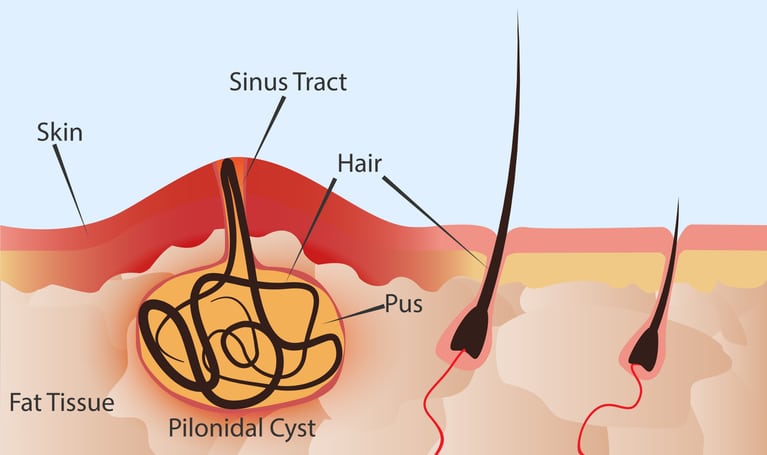At Kamrava Clinic, we acknowledge that the existence of pilonidal sinus may be quite discomforting. Whether it is your first attack or you have been treating recurrent cysts elsewhere, it is important to find the right pilonidal cyst treatment in order to enhance the joy of life living with such conditions. As said before, pilonidal cysts tend to be quite painful, irritating and all annoying but with the right approach, they can either be managed or treated completely.
Across this blog, we will provide ways of managing pilonidal cysts, including lifestyle changes, the available non-invasive procedures and the inevitable surgical approaches that will have to be employed.
What Are Pilonidal Cysts?

Pilonidal cysts are a skin-related defect characterised by the presence of a midline cystic cavity above the gluteal region. They often involve hair, pores and skin particles and various tissues and can become infected, especially abscesses. In the case of a pilonidal cyst, pain is the most prominent symptom, particularly while sitting down. You might also notice some inflammation, tenderness, or even possible discharge from the affected area.
The recurrent nature of the pilonidal cyst is a concern to many admirers of this cyst, hence the need to resolve the issue of supplying or constructing an effective treatment for the pilonidal cyst.
What causes recurrent pilonidal cysts?
The actual cause of pilonidal cysts is not always clear, however positive factors increase your risk of developing them. Prolonged sitting, excessive body hair and poor hygiene can contribute to the formation of cysts. It is not unusual for people with habitual cysts to have underlying factors that include continued growth of hair in the affected area or previous incomplete medication.
Understanding the triggers can help guide you toward the best pilonidal cyst treatments and prevention measures.
Treatment for pilonidal cysts at home
For people with mild or early cysts, there are some non-surgical strategies that could help control symptoms and undoubtedly save your cyst from getting worse:
1) Hygiene
Keeping the area clean and dry is essential. Cleansing the region with mild soap and water on a routine basis will help to lessen the chances of getting an infection.
2) Hair removal
Since hair often contributes to the formation of a pilonidal cyst, keeping the area free of hair can help prevent the fate from flaring up. Some sufferers have found success with daily shaving or laser hair removal to minimise tailbone growth.
3) Warm compresses
If you experience pain or swelling, applying warm compresses can help relieve pain and promote drainage if the cyst is already inflamed.
4) Over-the-counter pain relief
Pain medications that contain ibuprofen or acetaminophen are useful in managing pain and infection while alternate management strategies are being sought.
However, it is also necessary to stress that while these might also aid in the management of symptoms, they are not always curative. If the situation does not improve and the intrusions become alright in your cysts, measures should be taken and should be greater than just going for treatment of pilonidal cysts.
Non-surgical pilonidal cyst treatment options
When non-surgical strategies fail to manage symptoms or in the event that you revel in recurring cysts, it’s important not to forget medical intervention. The following treatments for a pilonidal cyst may provide relief without the need for surgery:
a) Antibiotics
The doctor may in some cases also include a course of antibiotics to clear the infection of a swollen pilonidal cyst. Besides that, other medications are advised to reduce the content symptoms associated with the cyst such as pain and inflammation, these antibiotics do not destroy the cyst.
b) Incision and drainage
The procedure entails a scar – becoming a procedure in which the healthcare provider creates a small cut in the cyst to relieve the pressure and drain out pus. It’s a short answer for immediate relief, but like antibiotics, it won’t save your cysts from coming back.
c) Minimally invasive procedures
For patients who enjoy frequent flare-ups, newer techniques, including laser treatment or pit picking, can provide a longer-term response without the need for major surgical treatment. These minimally invasive options allow hair and particles to be removed from the cyst cavity, reducing the likelihood of recurrence.
For many, these alternatives can provide a remedy, but habitual cysts can be an extra task. If your symptoms persist, surgical alternatives to pilonidal cyst treatment may be vital.
When is surgery necessary?
When other treatments fail, surgical options can offer a more permanent approach to pilonidal cysts. Surgery involves removing the cyst and surrounding tissue to prevent a similar recurrence. There are many types of surgical tactics available, relying on the severity of the cyst and your non-public health needs:
i) Wide excision
In this method, the doctor removes the cyst and the surrounding tissue, leaving the wound open to heal naturally. This method has a better execution cost, but requires a longer recovery time.
ii) Closed wound surgery
In a few cases, a healthcare professional may remove the cyst and suture the area around the wound. This allows for faster recovery, but there is hardly a greater chance of recurrence compared to open wound recovery.
iii) Flap surgery
For recurrent or complicated cases, valve surgery may be approved. This method involves reshaping close to the tissue to cover the cyst area, reduce tension in the wound and aid in faster recovery.
Your doctor will guide you through a quality pilonidal cyst treatment plan primarily based on your exact condition and long-term dreams.
Prevention of recurrence after treatment
The treatment of a pilonidal cyst cannot be viewed in isolation because everything has to be done to avoid the risk of development of new cysts following successful treatment. Although surgery is useful in minimising chances of recurrence, basic hygiene and the doctor’s orders regarding post-surgical care are also critical:
1) Keep the area clean and dry
The area should also be regularly cleaned and dried to avoid accumulation of bacteria and eventually, the development of more cysts.
2) Hair removal
Consider regular hair removal methods to reduce the risk of hair collecting in the cyst area.
3) Refrain from sitting for long hours
Sitting down for several hours puts pressure in the region of the tail bone which is a risk factor for development and aggravation of pilonidal cysts. Short breaks or walks can help reduce this stress.
Choosing the right treatment pilonidal cyst for you
Dr. Kamrava Clinic has a core belief that medicine should be client-friendly and offered on a bespoke basis to each and every disabled client. Cyst of sacrococcygeal pilonidal treatment can be intolerable and exasperating, however proper medication for pilonidal cysts can bring comfort for a long time. Whether you are looking for non-invasive treatments or are ready for surgery to correct the issue, our resources are available to you for each part of your journey.
Take the first step toward relief today
If you are equipped to find lasting relief from habitual pilonidal cysts, our team at Dr. Kamrava Clinic is here to help you. Dr. Kamrava Clinic has a core belief that medicine should be client-friendly and offered on a bespoke basis to each and every disabled client. Over the years of successful pilonidal cyst therapies we have developed an individual approach to your needs. Call us today at (424)2798222 to book your appointment and begin your journey to a life liberated from the pain and discomfort caused by pilonidal cysts.
Ready for relief? Schedule a consultation now!



